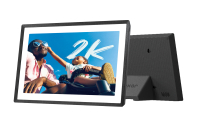Digital Camera World Verdict
The feature set of this photo frame belies its budget price tag. It's a bit plasticky when you get up close, but the simplistic design is easy on the eye and looks absolutely fine when perched on a shelf. Storage is particularly generous, and the touchscreen and companion app make it a breeze to use. Yes, better frames are available, but you really can't go wrong for the price.
Pros
- +
Much lower cost than 'brand name' frames
- +
Surprisingly well-featured, considering the price
- +
Images can be easily uploaded by multiple users
Cons
- -
Plasticky construction
- -
16:10 aspect ratio can crop images awkwardly
- -
1280 x 800-pixel so-so display doesn't show images at their best
Why you can trust Digital Camera World
Among the better-known brands of digital photo frames, such as Aura, Pexar and Nixplay, there are dozens of cheap and cheerful frames of Chinese origin available on Amazon, eBay, and other marketplace websites, so how do these budget alternatives compare with their big-name counterparts?
I plumped for an Aeezo Portrait frame, which has a standard 10.1-inch frame size and can upload images over Wi-Fi as well as from SD cards and USB memory drives. The LCD panel is surrounded by a black plastic bezel with a textured feel to it, which doesn't look particularly luxurious but doesn't look tacky either. It also comes in a solid white version and a black-and-white combo with a white inner bezel and black surround.
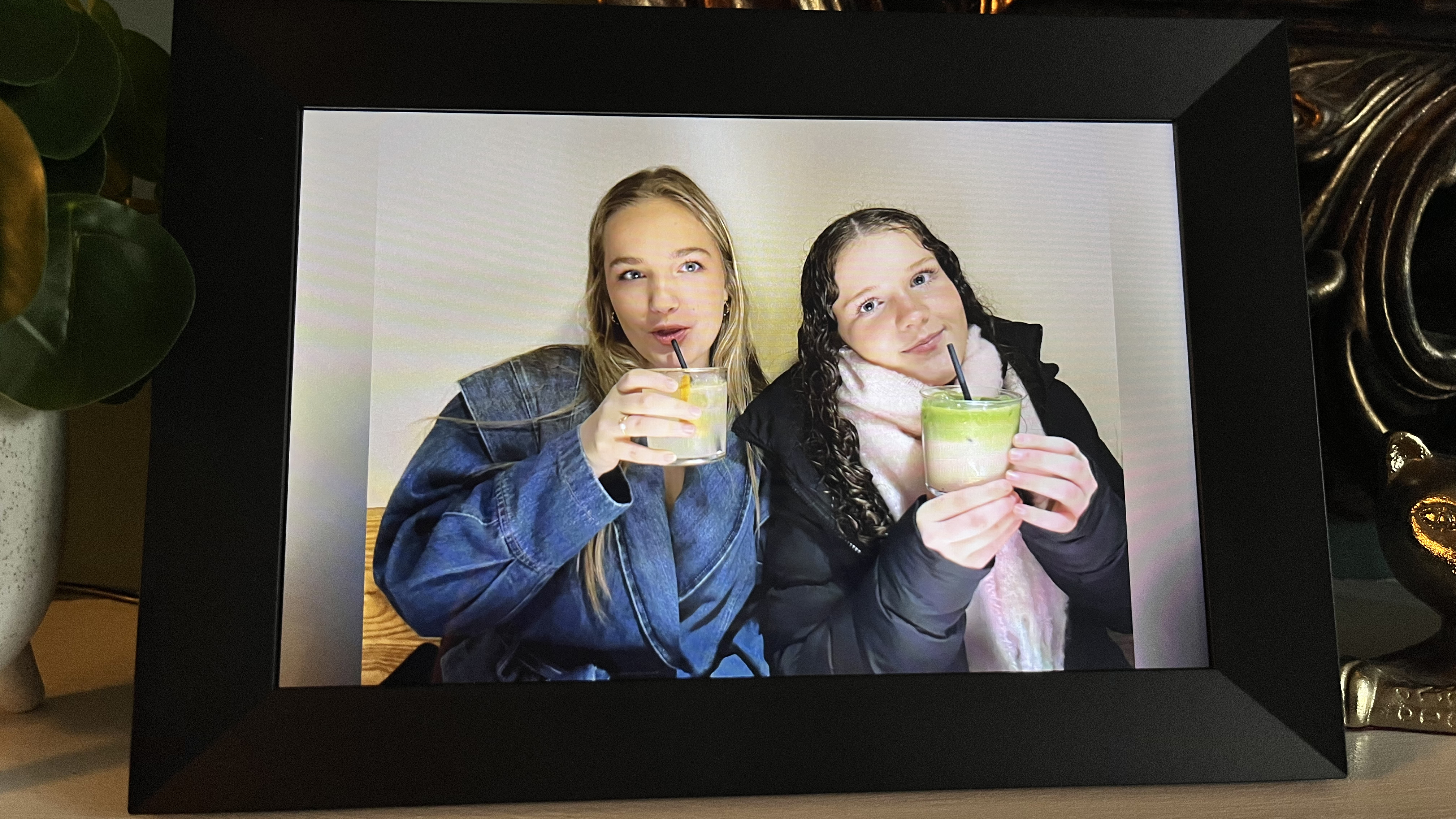


Aeezo Portrait 10.1in photo frame: Specifications
Display | 10.1-inch touchscreen |
Resolution | 1280 x 800 (150ppi) |
Inbuilt storage | 32GB |
Connectivity | Wi-Fi, SD, USB-A, USB-C |
Aspect Ratio | 16:10 |
Sound | Built-in speaker |
App | Aimor |
Orientation | Portrait / Landscape (Auto-Rotate) |
Aeezo Portrait 10.1in photo frame: Price
This 10.1-inch frame has a list price of $79.99 / £79.99 on Amazon's US / UK websites but was discounted to $53.99 / £59.99 at the time of purchase. Such discounting is fairly commonplace with these sorts of products, so do keep an eye out for deals. The first surprise was that while the product on the website has the brand name Aeezo, there is no mention of this on the product I received or any of its packaging, and the only branding was 'Aimor', which is actually the name of the app that it works with. Indeed, there looks to be a fair few similarly specced frames under different generic brands.
To add to the confusion, while I couldn't find the exact model on the Amazon Australia website, the Reumuar 10.1-inch Digital Photo Frame seems to be suspiciously similar in terms of looks and the spec sheet, with the same 1280 x 800-pixel display, 32GB storage, and auto-rotate and touchscreen functionality. The only real difference appears to be that this works with the Frameo app, rather than the Aimor app that comes with the Aeezo frame, but both those apps are similar in functionality, enabling easy upload of images from the phone library of multiple users.
Aeezo Portrait 10.1in photo frame: Design & Handling
The 10.1-inch screen has the 16:10 ratio commonly found on laptops and tablets, and is surrounded with a plain black plastic frame with a matt texture that is around an inch wide and has a shallow beveled design. First impressions are that it looks and feels more plasticky compared to more upmarket frames, but it is minimalist and unfussy. The 1280 x 800 resolution over 10.1 inches results in a pixel density of approximately 150ppi, which isn't as high-resolution as some, but images look reasonably crisp.
The frame is propped up by a long plastic stick that screws into one corner of the rear of the frame, and can thus support it in either portrait or landscape orientations. It's a rather inelegant solution, protruding by around five or so inches to offer enough support for the entire frame from just one corner. At least you won't see it if it's nestled on a bookshelf, but this does mean the frame has to have a fair amount of space behind it and can't sit flush against a wall or on narrow shelves. There are also a couple of hanging hook insets to mount the frame directly on a wall, although, as with other frames, this presents the usual problem of a trailing power cable. Most people will opt to pop it on a shelf or sideboard.
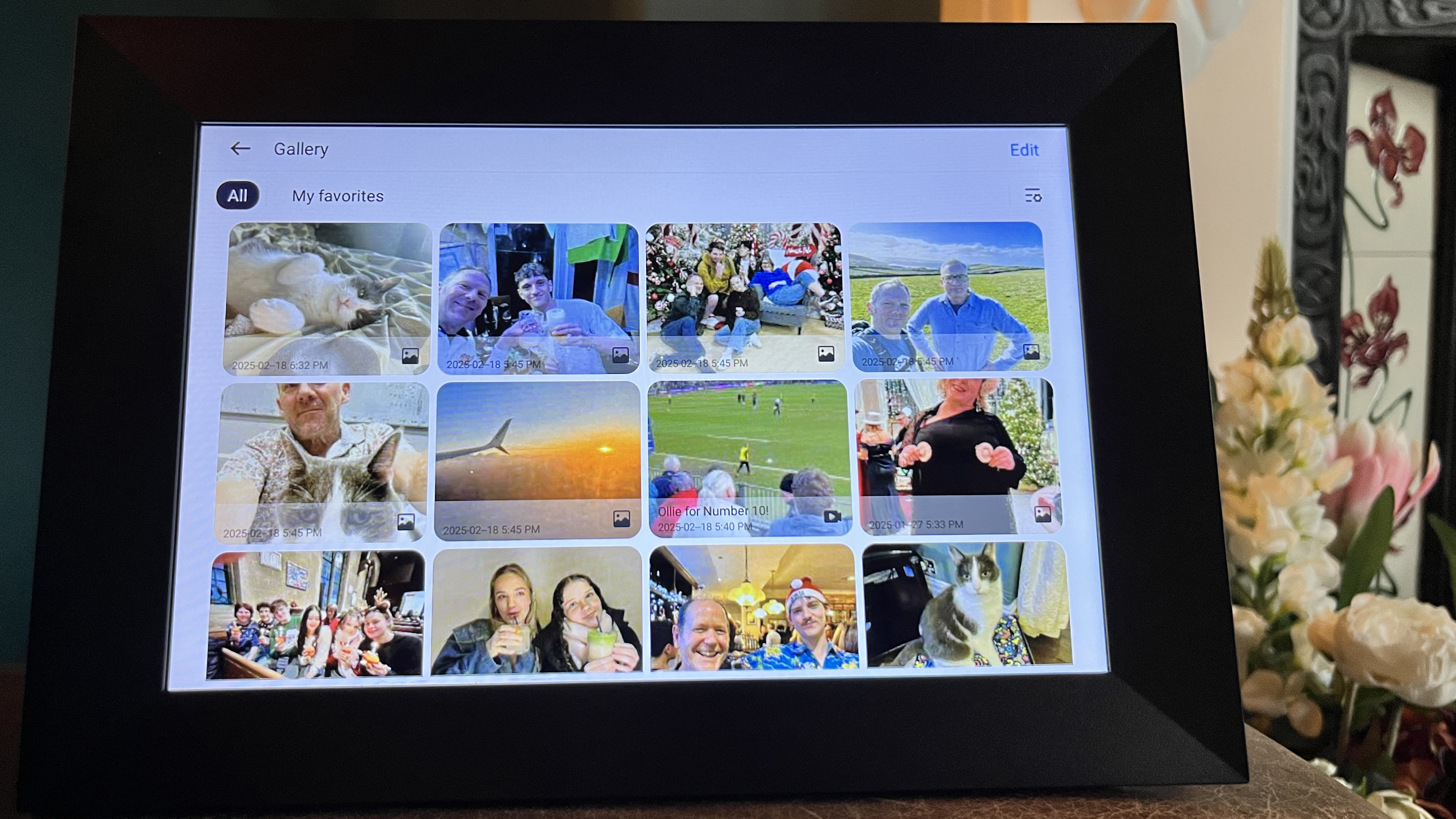
Images automatically rotate to suit the orientation of the frame, which is a nice touch that I'd normally only expect to find on more upmarket photo frames. There are slots for an SD card, as well as USB-A and USB-C memory sticks to upload images into the frame as an alternative to a Wi-Fi connection, however, the frame needs to copy the images from the plug-in device to its own internal memory, so you can't use external cards to expand the number of images the frame can store. That said, the 32GB is enough for many thousands of photographs.
It's not possible to download images wirelessly from your computer though; you will have to transfer using a memory card or flash drive, which is a little inconvenient if you primarily shoot on a camera rather than a phone.
The touchscreen functions well. Swiping to the right moves to the next image in the sequence, while a swipe to the left shows the previous one. Swiping up and down adjusts the display brightness. A tap brings up an onscreen menu that offers an option to fill the frame completely by cropping into the current image or fit the entire image, albeit surrounded by borders. You can pinch to zoom in and out of individual images and scroll around them using the touchscreen for the most pleasing composition.
There is also an option to switch between different 'galleries' held in the frame's storage, which could be handy to ensure that extended family photos are displayed when the inlaws visit, for example.
There are quick settings to adjust whether the time, temperature and captions are overlaid onto the display (I prefer to turn these off, to be as much like a 'real' picture frame as possible) as well as more in-depth settings for Wi-Fi access, slideshow control, and backing up the images from the frame to a memory card.
Aeezo Portrait 10.1in photo frame: Performance

Most of the functionality of the frame is controlled by the companion Aimor app, of which there are Apple and Andriod versions. It's easy to upload images from your phone photo library; images are displayed in a grid and you simply tap the ones you wish to upload, which are marked with a tick. You then have the option to add captions and crop images to control how they will display on the frame before uploading them. You can upload up to nine images at once; this rises to 50 if the phone and frame are on the same Wi-Fi network. If you want to do more then you will need to take out a paid Aimor subscription, which increases the number to 100 – or 200 on the same Wi-Fi network. Likewise, videos are limited to 15 seconds long subscription-free but can run up to two minutes if you pay. For most users, the free version will offer all the functionality they might want.
It's similar to the Frameo app that powers other photo frames, such as the Lexar Pexar, but the image management isn't quite as good, particularly when it comes to selecting the way that images are cropped. On the Frameo app, you tap the subject in each shot, and the app attempts to fill the frame so that this area of the image is centered, no matter whether it's in landscape or portrait orientation. But here you have to select a crop for the current orientation that the frame is in, and if later decide to orient the frame differently then the crop is lost and it's hemmed in by ugly borders. To be fair, most people will decide to keep the frame in one orientation and stick with it. And neither app is as good as the Aura one that powers its Walden and Carver frames, which, for the most part, automatically recognizes what's important in a scene and crops in intelligently.

The 10.1-inch screen is a reasonable size to display images, though its certainly not as showstopping as the bigger frames on the market, and the 1280 x 800 resolution is a little above 720p 'Standard Definition', but not by much. It equates to a pixel density around 150ppi, which is fine for most viewing distances, but not as stunning as some physically larger or more pixel-packed frames.
You can also invite other users to add their images to the frame. They need to download the Aimor app onto their own devices and set up an account. You then generate a code via your Aimor app or the frame itself, which you pass on to those you wish to grant access to. It's not quite as slick a system as some other apps but is perfectly functional. If you later change your mind, you can delete users' access again easily enough.
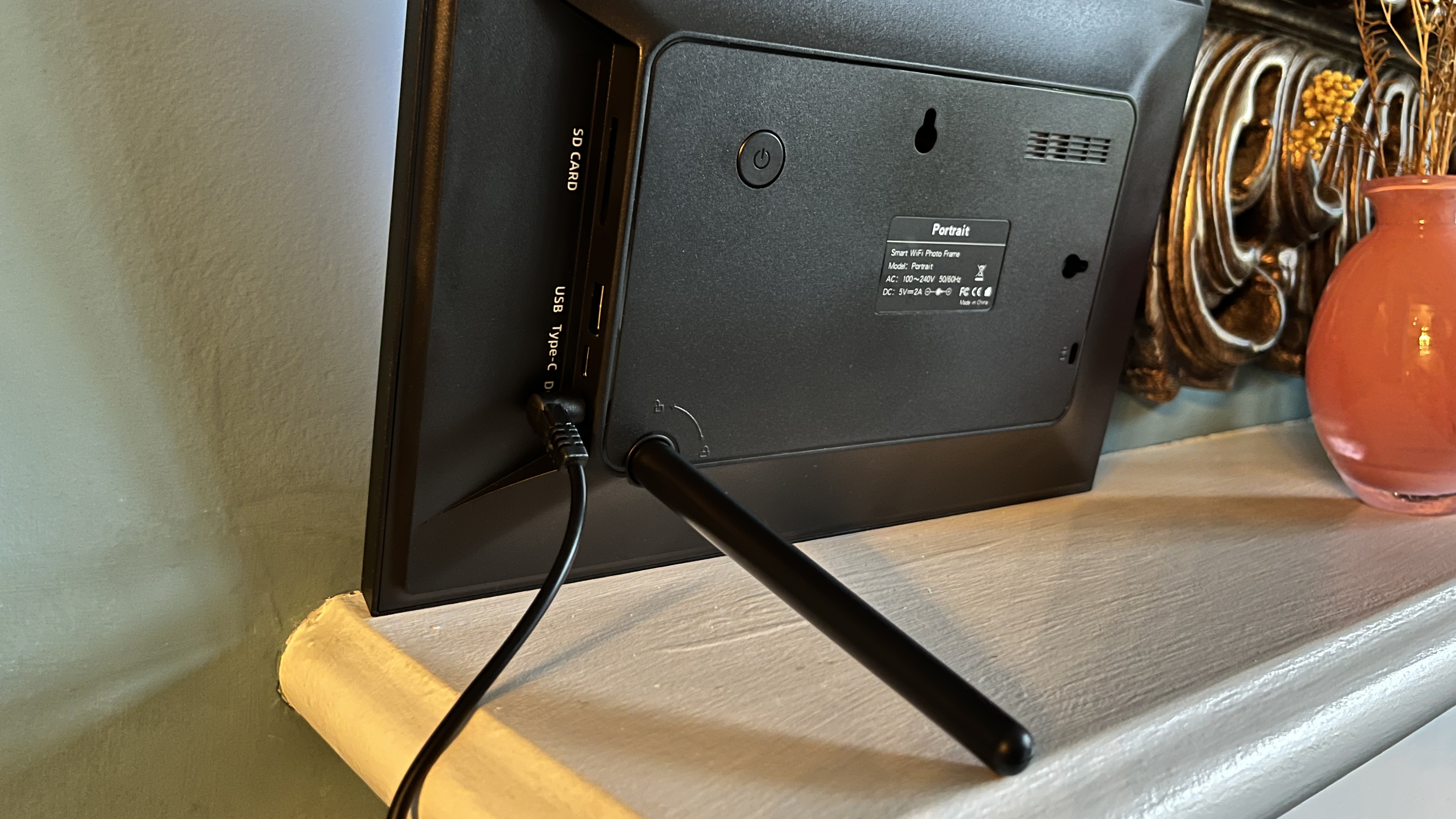
Aeezo Portrait 10.1in photo frame: Verdict
Sure, there are higher-resolution digital photo frames with larger and crisper screens around, and with more upmarket finishes, but I'm seriously impressed with the feature set that this budget frame offers for a very competitive price. The touchscreen is responsive, the storage is generous, and it can be used in either portrait or landscape orientation – whereas some pricer brand-name frames are strictly for horizontal viewing only.
The Aimor app that powers the frame is perhaps not as well rounded as some of its competitors, but it's perfectly functional and enables sharing from multiple users. For a fully featured frame with an affordable price tag, you really can't go wrong.
Features | Suprisingly well-specced, with 32GB memory, Wi-Fi connectivity and a touchscreen display | ★★★★☆ |
Design | It feels plasticky and its stand design is clunky, but it's inoffensive enough | ★★★☆☆ |
Performance | The touchscreen is responsive, but the Aimor app is functional rather than fantastic | ★★★★☆ |
Value | The screen is only average, but considering the price, you really can't complain | ★★★★★ |
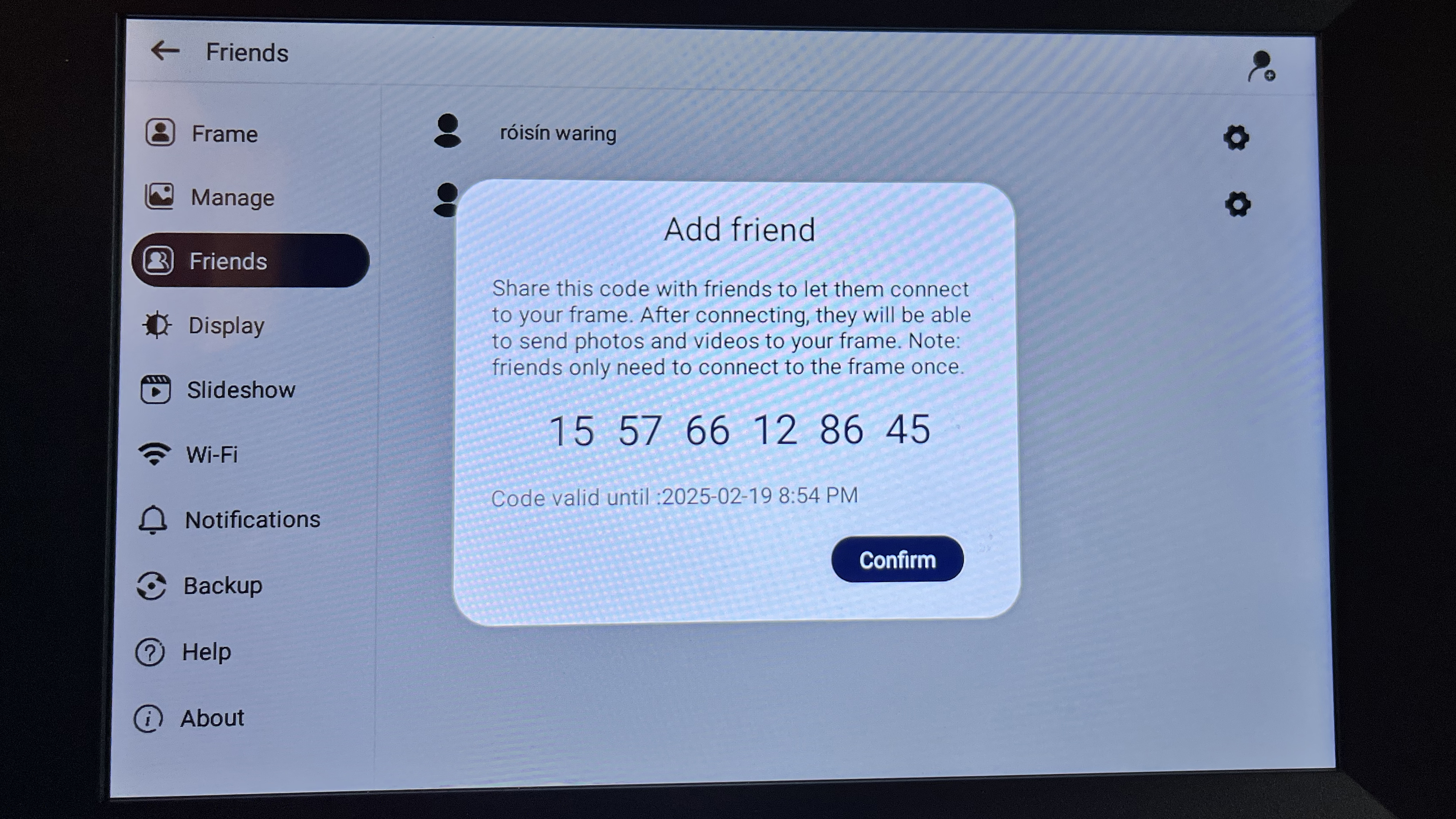
✅ Buy it...
- If you want a well specced frame for not a lot of outlay
- If you'd like family and friends to upload images too
🚫 Don't buy it...
- If you want a luxurious frame; this feels a bit cheap, but not too nasty
- If you want to show pictures in all their glory; the display is merely average
Alternatives
Lexar Pexar 11in photo frame
For a denser and much nicer display, the Lexar Pexar packs a gloriously high-res 2000 x 1200 pixels into an 11in frame and has a 100% Adobe sRGB color gamut. It also offers the same generous 32GB storage, and has SD, USB, and wireless connectivity.
Aura Carver
The Aura Carver has the same sized 10.1-inch display and 1280 x 800 resolution, but is a much classier frame and is easier to use, although it can only be used in horizontal orientation.

Prior to joining digitalcameraworld.com as Guides Editor, Adam was the editor of N-Photo: The Nikon Magazine for seven years, and as such is one of Digital Camera World's leading experts when it comes to all things Nikon-related.
Whether it’s reviews and hands-on tests of the latest Nikon cameras and lenses, sharing his skills using filters, tripods, lighting, L brackets and other photography equipment, or trading tips and techniques on shooting landscapes, wildlife and almost any genre of photography, Adam is always on hand to provide his insights.
Prior to his tenure on N-Photo, Adam was also a veteran of publications such as PhotoPlus: The Canon Magazine, so his wealth of photographic knowledge isn’t solely limited to the Big N.
You must confirm your public display name before commenting
Please logout and then login again, you will then be prompted to enter your display name.

